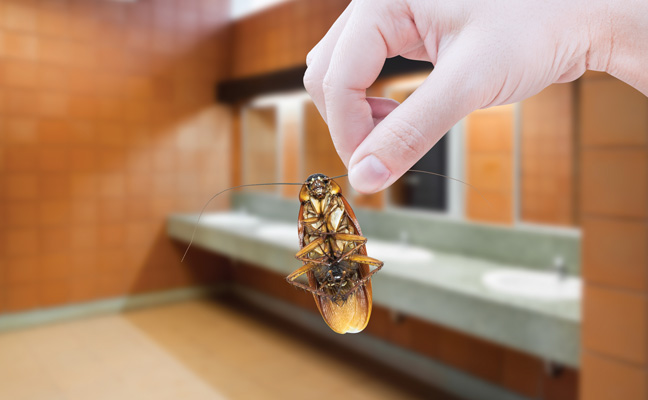
Naturally, the Cockroach Promotion Board holds all its meetings in a public restroom, with offsite trade shows at various restaurant kitchens. PHOTO: RAWINTANPIN/ISTOCK / GETTY IMAGES PLUS/GETTY IMAGES
Get to know the cockroach… or representative. Cockroach Promotion Board director speaks out:
Pest Management Professional magazine (PMP): Today, we are focusing one of the most resilient insects on Earth: the cockroach. With me today is the executive director of the Cockroach Promotion Board. So wow, there is an organization to promote cockroaches?
Executive Director (ED): To us, there is nothing strange about having an international board to promote cockroaches. It seems like any group needs to be represented. I mean, you have national, state and local associations, don’t you?
PMP: Fair point. OK, let’s talk about a hot topic right now: Cockroaches are on the list of Public Health Pests authored by the U.S. Environmental Protection Agency (EPA) in 2002, titled PRN 2002-1. Why is being on that list significant?
ED: Because products are developed and submitted to the EPA for registration, the agency decided to prepare a list of imminent public health pests that would require a data review to make sure any product claiming efficacy works. By the way, we are not alone. The Public Health Pest list includes other insects, rodents, certain wildlife, and microorganisms.
(MORE: View the 2002 Public Health Pest list, and the latest news on the updates to the 2021 list.)
PMP: Here’s the timely part: The EPA recently proposed updates to the list, and we expect a revised list by February. As things evolve, pests such as bed bugs have been added.
ED: That is correct. But we’re proud to still be on the list!
PMP: Let’s talk treatment. How have the control measures you fear changed in recent years?
ED: Well, your industry definitely has shifted from spraying baseboards to using a targeted approach with baits. It seems like yesterday that cockroach control was the toughest challenge for your technicians. Now, it seems we’re more of a numbers game than a true technical challenge.
PMP: Why are cockroaches such a public health concern?
ED: It has been established that cockroaches can be the source of allergens, and can trigger an asthmatic reaction in humans. While most of the public think of cockroaches merely as disgusting and a nuisance, we do pose a serious health issue for asthmatics. We also spread pathogens to everyone, as we run through contaminated areas like sewers and then onto human food.
PMP: Are you proud of your influence on human living?
ED: We have been very successful, and trace our ancestry back perhaps millions of years. We are survivors, and do well in nearly any part of the world. In warmer climates, we thrive outdoors; in all climates, we do well indoors.
PMP: Identifying a cockroach is easy, but narrowing a cockroach down to species so we can understand biology and habits can be hard. Can you explain?
ED: It is always best to take the time to properly identify, and then go to the sources and carefully apply the preferred product per the label. But our group realizes identifying cockroach nymphs in particular sometimes can be confusing. We even misidentify them as bed bugs sometimes! That’s why we recommend that your industry expand its training focus from just adults of the species, to more on what cockroaches can look like during their entire life cycle.
PMP: Gee, you have been very forthcoming. Thank you for your candor.
ED: You’re welcome. We’re not worried about our population decreasing. If the public keeps feeding us and giving us access to water, we’ll always be around.
BAUMANN, a PMP Hall of Famer (Class of 2013), is VP of technical services and regulatory affairs for Nisus Corp., Rockford, Tenn. He can be reached at gregb@nisuscorp.com.
The post An interview with a cockroach appeared first on Pest Management Professional.
source https://www.mypmp.net/2021/01/22/an-interview-with-a-cockroach/
No comments:
Post a Comment